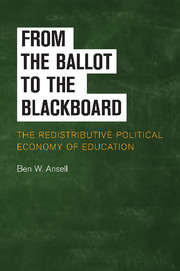Book contents
- Frontmatter
- Contents
- List of Tables
- List of Figures
- Preface
- 1 THE REDISTRIBUTIVE POLITICAL ECONOMY OF EDUCATION
- 2 THE EXPANSION OF EDUCATION TO THE MASSES: THEORY AND DATA
- 3 THE EXPANSION OF EDUCATION: HISTORICAL EVIDENCE
- 4 THE PARTISAN POLITICS OF EDUCATION
- 5 HIGH POLITICS IN HIGHER EDUCATION
- 6 CONCLUSION
- Bibliography
- Index
- Titles in the Series
2 - THE EXPANSION OF EDUCATION TO THE MASSES: THEORY AND DATA
Published online by Cambridge University Press: 06 July 2010
- Frontmatter
- Contents
- List of Tables
- List of Figures
- Preface
- 1 THE REDISTRIBUTIVE POLITICAL ECONOMY OF EDUCATION
- 2 THE EXPANSION OF EDUCATION TO THE MASSES: THEORY AND DATA
- 3 THE EXPANSION OF EDUCATION: HISTORICAL EVIDENCE
- 4 THE PARTISAN POLITICS OF EDUCATION
- 5 HIGH POLITICS IN HIGHER EDUCATION
- 6 CONCLUSION
- Bibliography
- Index
- Titles in the Series
Summary
INTRODUCTION: TWO PATHS TO EDUCATION?
The southern African kingdoms of Swaziland and Lesotho appear at first glance to be twins. Both states have populations of just over one million, low per capita incomes, near-identical demographic structures, and mountainous terrains, and are enveloped (entirely in the case of Lesotho) by the country of South Africa. Hence, one might expect both countries to face similar challenges in providing public infrastructure and investment. However, in terms of education spending, the countries stand in sharp contrast, with Lesotho spending twice as much of its national income on education as Swaziland. This distinction is a new one. In the mid–1980s, the two countries both spent around 6 percent of national income on education. But in the early 1990s, Lesotho began to diverge from Swaziland, at points spending over 10 percent of its national income, whereas Swaziland's investment actually declined.
What explains this divergence? In Lesotho in 1993, Major General Elias Phisoana Ramaema handed over power to a democratically elected government headed by the previously banned Basutoland Congress Party. Although that government faced a variety of challenges to its control over the following five years, including two attempted coups, democracy has slowly become institutionalized and Lesotho has experienced peaceful and fair elections over the past decade.
- Type
- Chapter
- Information
- From the Ballot to the BlackboardThe Redistributive Political Economy of Education, pp. 20 - 71Publisher: Cambridge University PressPrint publication year: 2010

